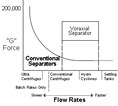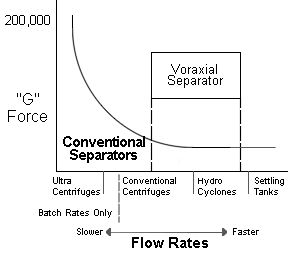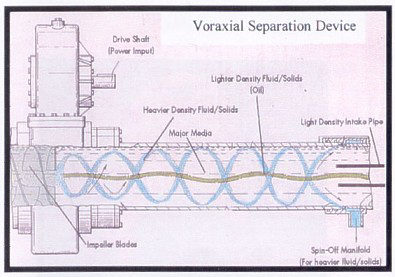Efficient, High-G Turbo System Separates Mixed Fluids Based on Specific Gravity

According to Enviro, VAS is the only industrial separator to combine both high g-forces and high flow rates (up to 1 million gpm). It generates much higher g-forces than centrifuge and hydrocyclone. It may also have an energy advantage. Enviro claims VAS requires only 0.007 horsepower to process 1 gal in 1 minute. Conventional centrifuges need 0.2-0.7 hp/gpm.

It also goes head-to-head with conventional filters. It appears competitive in systems that require high throughput or systems where space is at a premium. The system is especially good at separating particulates, which are easily recovered as a slurry stream. Nor does VAS demand the same level of maintenance and period back flushing required by filters.
Although the first commercial installation came at a metal finishing plant, Enviro CEO Alberto Di Bella tells Chemical Online that VAS has many chemical, refining, and process industry uses.
"The machine itself is a universal machine," says Di Bella. "We're creating the era of computer numerical controlled, or CNC, separations. Just input the parameters and get the separation you want. You could apply the machine inline at a refinery or anywhere else."
The Voraxial Separator has several interesting design features:
- Open-center fluid flow. Impeller blades affixed to the inside perimeter of an impeller drum eliminate hubs, shafts, and struts that impede high-velocity flow in conventional equipment. The design dramatically reduces clogging.
- Blade design. Symmetrical impeller blades quickly reverse, running in either direction with maximum efficiency. Blade design slashes shear. This significantly reduces low-pressure areas behind the blades that cause cavitation.
- Inline configuration. Inline VAS installation lets fluids pass freely when not operating and requires less than half the startup time of conventional pumps.
- Flexibility. Interchangeable blades permit use of the impeller designs chop, mix, homogenize, diffuse, separate, extract, thrust, and aerate - all at higher specific speeds and lower operating costs.
Enviro has used VAS to separate all types of oil from water. Tests show reductions of oil to less than 5 ppm in water. It separates heavy particles through specific gravity weight differentiation. Sand, metal chips, silt, and other solids are forced to the outer periphery and discharged through the patented manifold.

Enviro, a small public company, is targeting the metal fabrication and finishing processes for water recycling and remediation initially. The industry uses a variety of acids and chemicals to produce nickel, chromium, and zinc baths, says Di Bella.
"They have to remove the metal particles before they can release the water," he continues. "They have a lot of equipment, usually a series of tanks, that remove metals as sludge. It takes about 3000 sq ft.
"We can do the same thing with a machine 2 ft wide x 4 ft high x 5 ft long. They can reuse or release most of the water directly into the system directly after processing."
How well does it work? According to Di Bella, independent laboratory tests show that VAS reduces metal industry contaminants in water to levels lower than those required by the Environmental Protection Agency (EPA).
It's also economical. Di Bella's models predict VAS slashes metal fabrication/finishing water treatment costs by up to 80%. He says there are more than 100,000 US metal fabrication/finishing sites that might benefit from the technology.
For more information: Alberto Di Bella, CEO, Enviro Voraxial Technology, Inc., 98 SE 7th St., Deerfield Beach, FL 33441. Phone: 954-421-6141. Fax: 954-421-3062. Email: info@evtn.com. URL: www.evtn.com.
By Alan S. Brown
